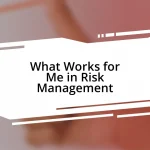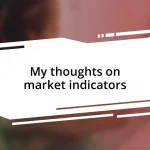Key takeaways:
- Understanding market volatility is essential for investors, as it encompasses emotional reactions and various influencing factors.
- Monitoring indicators like the VIX, trading volume, and moving averages can help anticipate market shifts and improve investment strategies.
- Evaluating personal risk tolerance through introspection and regular performance assessments significantly reduces anxiety and enhances decision-making.
- Adapting trading techniques and refining strategies through feedback and data analysis fosters flexibility and helps navigate market fluctuations effectively.
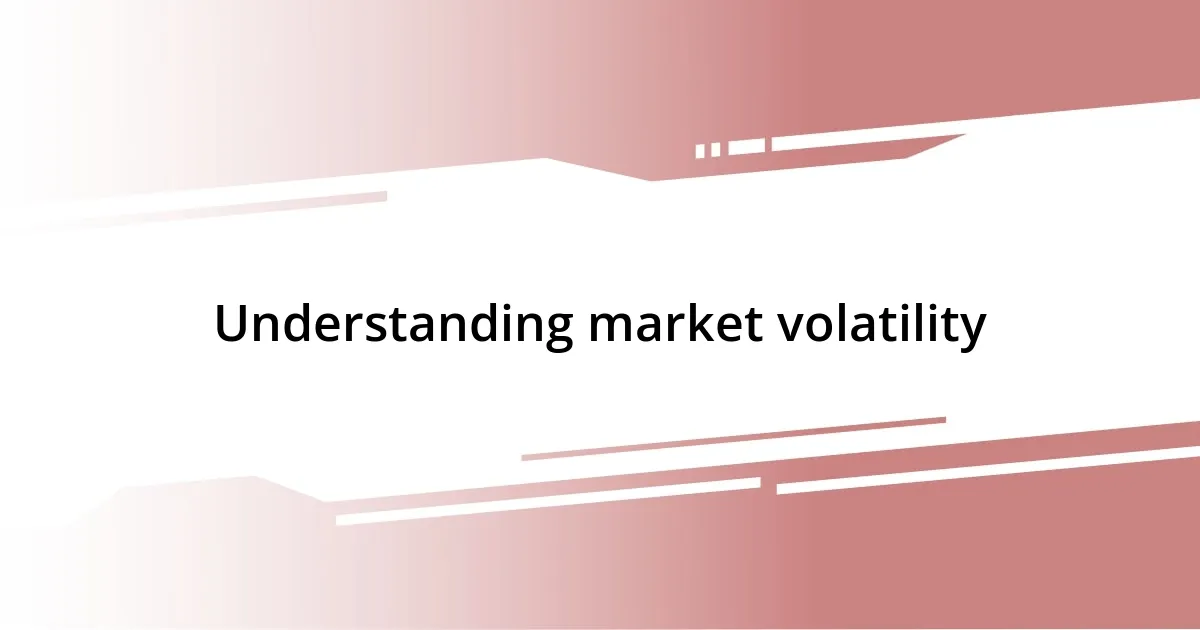
Understanding market volatility
Market volatility can feel like a rollercoaster, leaving many investors anxious about their portfolios. I remember my first experience with a sudden market dip; it felt as if the ground was pulled from under me. That panic taught me that understanding volatility is essential—it’s not just about price swings, but also about the underlying factors that can cause them.
Many might wonder, why do these fluctuations happen in the first place? Economic indicators, geopolitical events, and even investor sentiment can trigger dramatic shifts. Personally, I find it fascinating how a single tweet or news report can send markets tumbling one day and soaring the next. It’s a reminder that market behavior is often more emotional than logical—a concept that still surprises me.
I’ve learned that accepting volatility as an inevitable part of investing can be liberating. Instead of dreading the next downturn, I now see it as an opportunity to reassess and adjust my strategies. Have you ever considered how embracing these fluctuations could change your approach to investing? It certainly has for me, shifting my perspective from fear to proactive engagement.
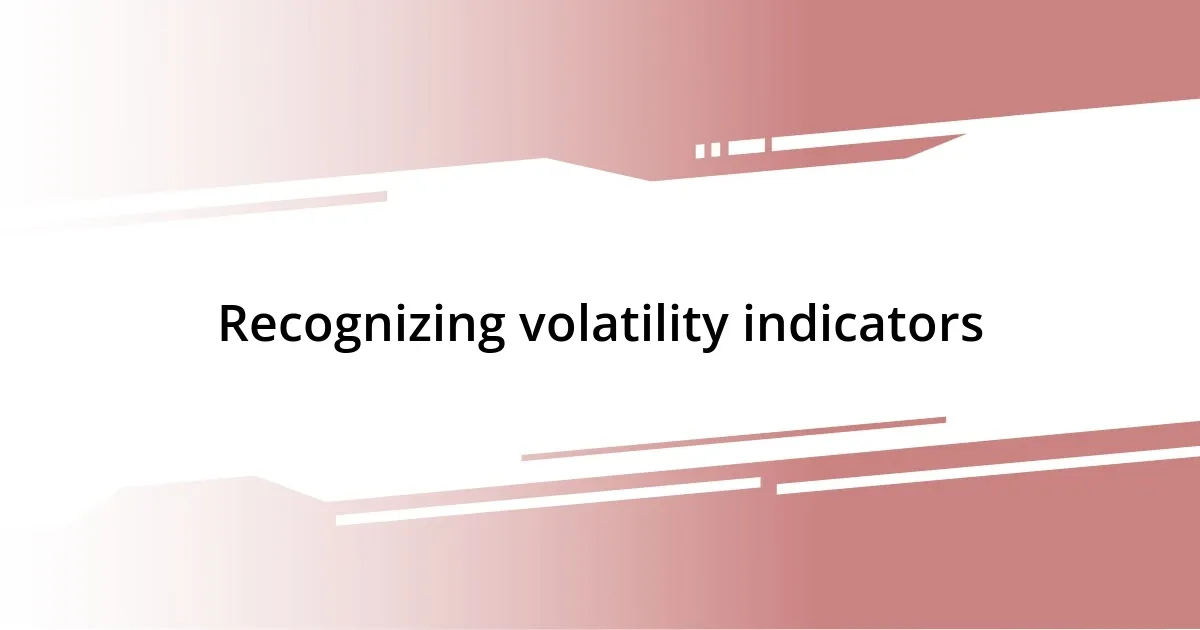
Recognizing volatility indicators
Recognizing volatility indicators involves tuning into the signals that indicate a shift in market dynamics. For instance, I often pay close attention to the VIX, known as the “fear index.” There was a time when I was caught off-guard by a sudden spike in this index, which led me to realize that a negative market sentiment was brewing. By keeping a daily check on such indicators, I find I’m better prepared for what lies ahead.
Another critical aspect is analyzing trading volume. When I noticed unusual spikes in volume during a seemingly quiet market period, it often signaled an impending shift. Once, I experienced a rapid trend reversal while trading a stock with increasing volume; understanding this indicator helped me avoid a significant loss. Recognizing these shifts empowers me to react instead of just respond, making my investment strategies far more resilient.
Lastly, technical indicators like moving averages can assist in gauging volatility. I recall using a 50-day moving average during a turbulent period; when prices crossed below this line, it prompted me to reevaluate my holdings. It’s remarkable how these indicators not only reflect patterns but can also lead to crucial decisions in our investment journeys.
| Indicator | Description |
|---|---|
| VIX (Volatility Index) | A measure of market risk and investor sentiment, often termed the “fear index.” |
| Trading Volume | The number of shares traded during a given time, indicating market activity. |
| Moving Averages | Indicators that show average asset price over a set timeframe, useful for identifying trends. |
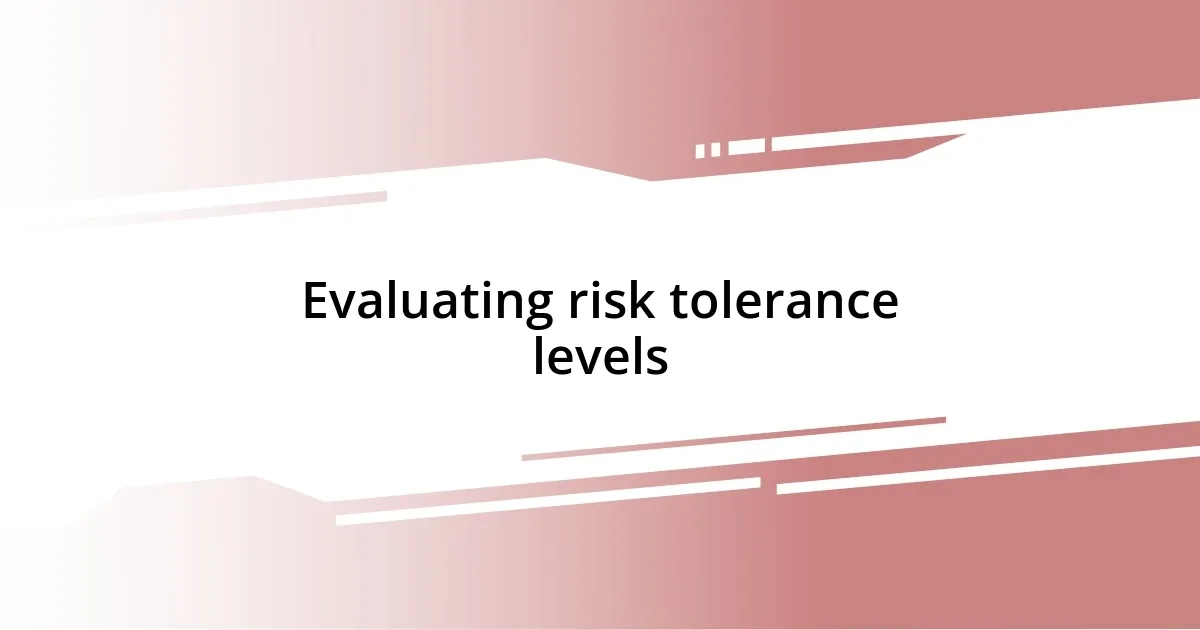
Evaluating risk tolerance levels
Evaluating my risk tolerance level has been a journey of self-discovery. Early on, I didn’t take the time to truly understand my own comfort with risk, which led to sleepless nights during market fluctuations. I remember watching my portfolio dip significantly and feeling like I was on the edge of a cliff. Through that experience, I realized it was crucial to define what risk meant for me personally and to assess my emotional reactions in different situations.
To help evaluate my risk tolerance, I found it useful to consider the following factors:
- Time Horizon: How long do I plan to stay invested? A longer time frame can often allow for more risk.
- Financial Goals: What am I investing for? Knowing my objectives helps determine my capacity for risk.
- Emotional Resilience: How do I react to market swings? Understanding my emotional responses allows me to make more informed decisions under pressure.
- Experience Level: How much market knowledge do I have? Higher familiarity can translate to greater confidence in taking risks.
- Current Financial Situation: Am I in a stable financial position? Recognizing my financial health impacts my ability to absorb losses.
By introspecting and assessing these aspects, I’ve become more deliberate about my investments, which has curbed my anxiety considerably.
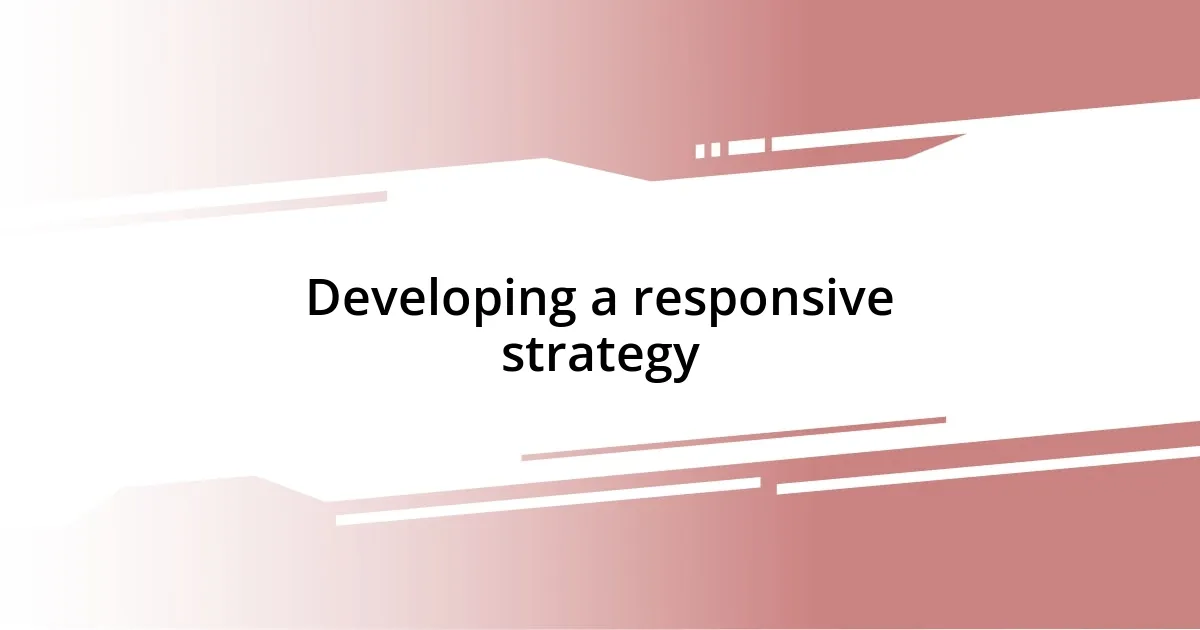
Developing a responsive strategy
When developing a responsive strategy, I often reflect on how flexibility can make a significant difference. One time, I found myself sticking rigidly to a plan when a sudden downturn occurred. It wasn’t until I adapted my strategy to include a reactive element that I regained control. By allowing my investments to shift in response to market movements, I learned that being nimble is just as important as having a solid plan.
A key part of this approach is regularly revisiting and updating my strategies. For instance, I once set a target price for a stock without accounting for changing market conditions. When it dipped below my target, I hesitated to act. After that experience, I began to adjust my targets based on market trends rather than sticking to initial definitions. This realization opened my eyes to the importance of continuously evaluating and adjusting based on real-time data.
Engaging with tools such as alerts and automated systems can also enhance responsiveness. I remember implementing a simple alert for one of my trades. When the price hit a certain level, I received an immediate notification that allowed me to make a quick decision. Have you ever been in a situation where a timely response changed the course of your investment? I’ve found that these proactive measures not only reduce stress but also enhance my ability to capitalize on opportunities as they arise.
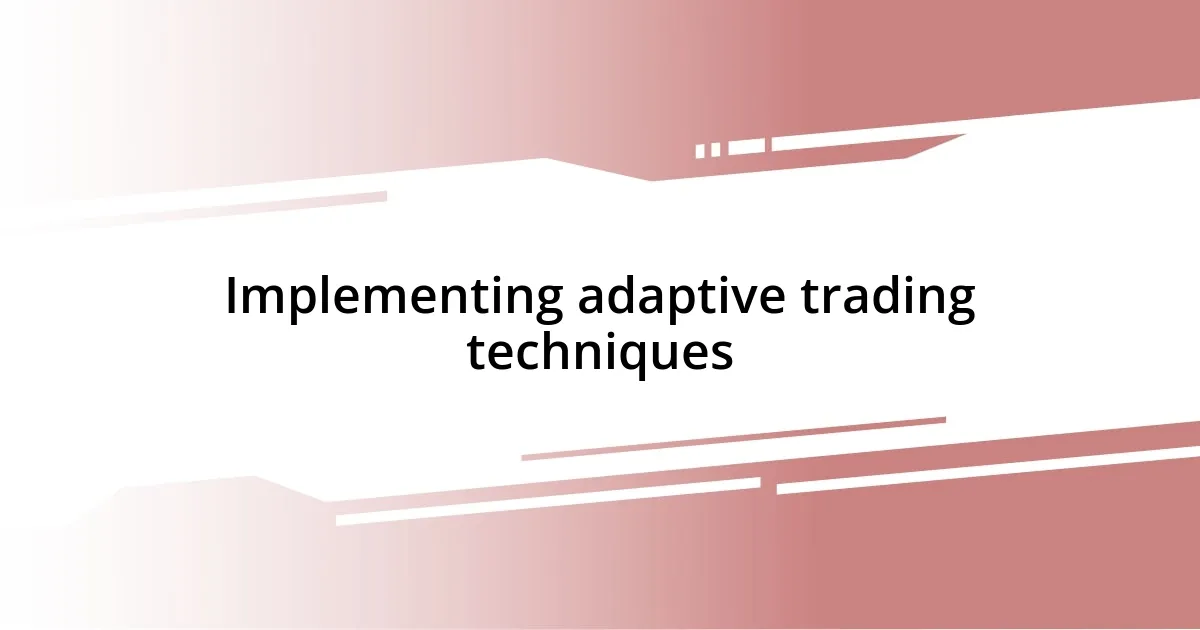
Implementing adaptive trading techniques
Adapting trading techniques requires a mindset shift that embraces change, and I can’t stress enough how crucial this has been for my own trading journey. One time, I stuck to a specific investment plan even when signs were indicating a shift in market dynamics. It felt challenging to let go of my original strategy, but once I did, I realized that flexibility can lead to unforeseen opportunities. Were you ever hesitant to change your course of action? I found that being open to adjustments transformed my approach and reduced my stress significantly.
Incorporating real-time analytics was another game changer for me. I vividly remember a particular day when my watchlist alerted me to a volatile stock plummeting. Instead of panicking, I swiftly accessed data on recent trading trends, which helped me decide whether to hold or sell. That quick decision felt empowering and reminded me how important it is to remain informed. Have you ever found yourself overwhelmed by sudden market movements? In those moments, having reliable data at my fingertips was invaluable, turning anxiety into strategic action.
Another essential aspect has been building a diverse toolkit of adaptive techniques. For instance, I once began using trailing stops to safeguard my profits while allowing for potential gains. Initially, it felt like letting go of control, but now I see it as a safety net. It protects me from significant losses while still giving my investments room to breathe in positive markets. What tools have you considered using to manage volatility? Embracing technology has definitely elevated my trading game, allowing me to focus more on long-term growth instead of short-term panic.
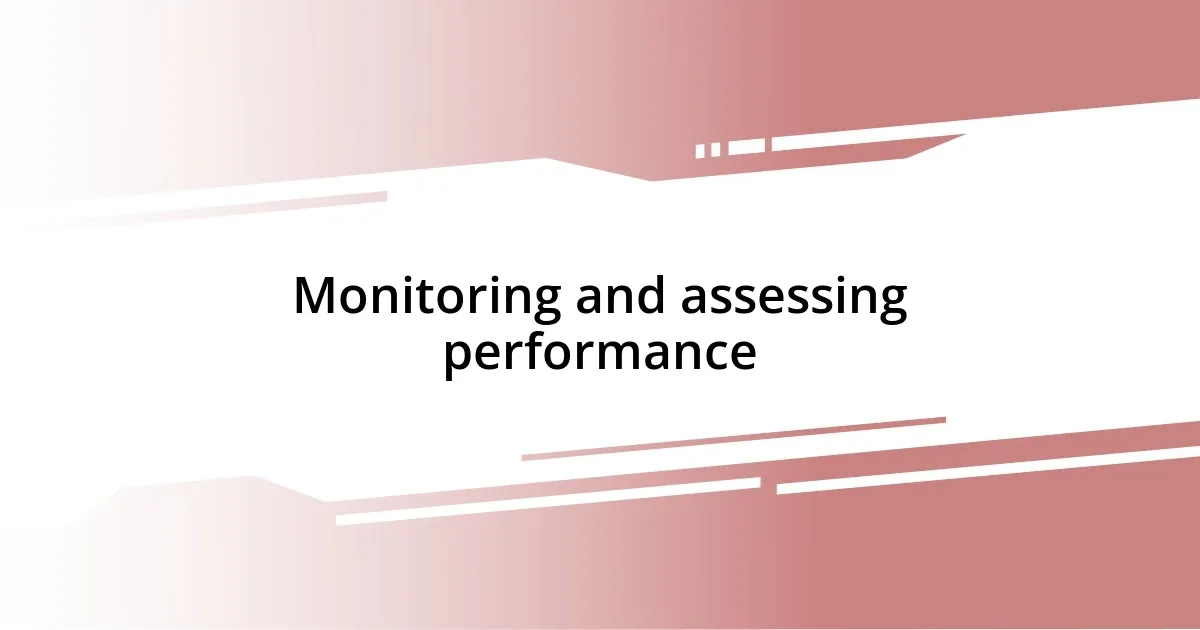
Monitoring and assessing performance
Monitoring and assessing performance has been a crucial aspect of my investing journey. After every major market movement, I take the time to review how my strategies performed. It’s not just about looking at numbers; it’s about understanding what drove those results. For instance, I remember one occasion when my portfolio took a hit due to unforeseen news. Instead of ignoring the data, I dove deep into the analytics to figure out what went wrong. Have you ever felt the urge to avoid analyzing a loss? I learned that confronting those situations head-on provided some of the best learning experiences.
Using a scorecard approach has been particularly useful for me. I track key performance indicators, such as return on investment and volatility levels, regularly. By writing these down, I can visualize trends over time and stay accountable to my financial goals. One time, I discovered a pattern that indicated I was too heavily invested in a sector that was becoming increasingly unstable. Catching that early really empowered me to rebalance my portfolio, something I might have missed without that regular assessment. How do you keep track of your own performance?
Incorporating feedback loops into my strategy has also made a difference. After implementing changes, I make it a point to review their impact systematically. I had a season where I adjusted my approach to focus more on dividend stocks, but I didn’t evaluate the outcome until months later. When I finally did, I was pleased to see steady growth. This journey of continuous improvement can be incredibly fulfilling. Have you set aside time to reflect on your own strategies? I can’t emphasize enough the importance of these assessments; they make navigating the ever-changing market landscape feel more manageable and even exciting.

Refining strategies for future changes
Refining strategies for future changes has become a vital part of my approach. There was a time when I felt overwhelmed by the chaos of market fluctuations, and I realized I had to rethink my strategies. By preparing for various scenarios, I found clarity amid uncertainty. Have you experienced that moment of realization when you know a shift is necessary? I remember the relief that washed over me when I decided to create different action plans for potential market conditions.
I also learned the importance of embracing feedback, both from my trading experiences and insights from fellow investors. I vividly recall a conversation with a more seasoned trader who introduced me to the idea of shadow trading—essentially testing new strategies without fully committing capital. This practice helped me gain confidence without the pressure of immediate financial repercussions. What new methods have you explored to sharpen your future strategies? For me, those discussions have often sparked innovative ideas I wouldn’t have considered on my own.
As I look ahead, integrating insights from past performances feels empowering. After one particularly tumultuous quarter, I reevaluated my asset allocation. It wasn’t easy to face the reality that I had spread myself too thin, but acknowledging that allowed me to focus on what truly worked. That experience taught me to prioritize quality over quantity. How often do you take the time to assess what you truly value in your investments? Emphasizing the essence of refining my strategies continues to shape my trading future.










